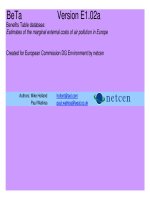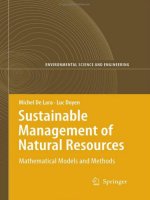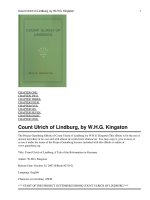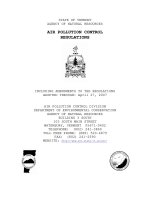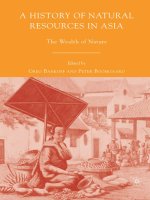A History of Natural Resources in Asia pptx
Bạn đang xem bản rút gọn của tài liệu. Xem và tải ngay bản đầy đủ của tài liệu tại đây (3.29 MB, 305 trang )
A History of Natural
Resources in Asia
9781403977366ts01.qxd 26-6-07 09:00 PM Page i
This page intentionally left blank
A History of Natural
Resources in Asia
The Wealth of Nature
Edited by
Greg Bankoff
and
Peter Boomgaard
9781403977366ts01.qxd 26-6-07 09:00 PM Page iii
A HISTORY OF NATURAL RESOURCES IN ASIA
Copyright © Greg Bankoff and Peter Boomgaard, 2007.
All rights reserved. No part of this book may be used or reproduced in any
manner whatsoever without written permission except in the case of brief
quotations embodied in critical articles or reviews.
First published in 2007 by
PALGRAVE MACMILLAN™
175 Fifth Avenue, New York, N.Y. 10010 and
Houndmills, Basingstoke, Hampshire, England RG21 6XS
Companies and representatives throughout the world.
PALGRAVE MACMILLAN is the global academic imprint of the Palgrave
Macmillan division of St. Martin’s Press, LLC and of Palgrave Macmillan Ltd.
Macmillan® is a registered trademark in the United States, United Kingdom
and other countries. Palgrave is a registered trademark in the European
Union and other countries.
ISBN-13: 978–1–4039–7736–6
ISBN-10: 1–4039–7736–4
Library of Congress Cataloging-in-Publication Data is available from the
Library of Congress.
A catalogue record for this book is available from the British Library.
Design by Newgen Imaging Systems (P) Ltd., Chennai, India.
First edition: September 2007
10987654321
Printed in the United States of America.
9781403977366ts01.qxd 26-6-07 09:00 PM Page iv
Contents
List of Figures vii
List of Tables ix
Contributors xi
Preface xv
Introduction: Natural Resources and the
Shape of Asian History, 1500–2000 1
Greg Bankoff and Peter Boomgaard
1 Natural Resource Management and Mismanagement:
Observations from Southeast Asian Agricultural History 19
David Henley
Part 1 Resources and State
2 The Physical Transformation of the Central Thai
Region in Premodern Times 41
Baas Terwiel
3 Poor Little Rich Islands: Metals in Bangka-Belitung
and West Kalimantan 61
Mary Somers Heidhues
4 Making Places and Making States: Agriculture, Metallurgy,
and the Wealth of Nature in South India 81
Kathleen Morrison
Part 2 Forests and Development
5 Almost an Embarrassment of Riches: Changing Attitudes
to the Forests in the Spanish Philippines 103
Greg Bankoff
6 Seeing the Timber for the Forest: The Wood in
Japanese Capitalism 123
Gregory Clancey
9781403977366ts01.qxd 26-6-07 09:00 PM Page v
7 Burma and the Politics of Teak: Dissecting a Resource Curse 143
Raymond Bryant
8 Losing Ground: Development, Natural Resources, and
the Dispossession of Malaysia’s Orang Asli 163
S. Robert Aiken
Part 3 Environments and Livelihoods
9 From Riches to Rags? Rice Production and Trade in
Asia, Particularly Indonesia, 1500–1950 185
Peter Boomgaard
10 Instructive and Nourishing Landscapes: Natural
Resources, People, and the State in Late Imperial China 205
Francesca Bray
11 Demographic Growth, Agricultural Expansion, and
Livestock in the Lower Chindwin in the Eighteenth
and Nineteenth Centuries 227
Michael Charney
12 “Stealing From the Gods”: Fisheries and Local Use
of Natural Resources in Vietnam 1800–2000 245
John Kleinen
Index 265
CONTENTSvi
9781403977366ts01.qxd 26-6-07 09:00 PM Page vi
List of Figures
1.1 On the Pada Grassland in Central Sulawesi, 1910 25
4.1 Map of the Vijayanagara Region 83
4.2 Masonry-Faced Reservoir Embankment in the Daroji Valley 88
4.3 Reservoir Made Redundant by the sixteenth-century
Anegondi Channel 90
4.4 Avinamodugu Reservoir Sluice Gate Buried
in ca. 3 Meters of Silt 94
5.1 Philippines Forest Cover 1908 107
5.2 Revenue Generated by the Inspección General de Montes 110
10.1 Irrigating the Fields, Gengzhi tu, Yuan dynasty version 206
10.2 Poldered Fields, Wang Zhen, Nongshu (Agricultural Treatise) 213
10.3 Weaving Silk Cloth on a Drawloom, Gengzhi tu, 1742 version 215
10.4 Harvesting Cotton, Mianhua tu 216
12.1 Marine Fish Landings, 1913–2000 248
9781403977366ts01.qxd 26-6-07 09:00 PM Page vii
This page intentionally left blank
List of Tables
5.1 Forest Cover and Population, 1565–1950 108
5.2 Type and Amount of Timber Cut by Doroteo
Inocencio, 1888–89 114
9781403977366ts01.qxd 26-6-07 09:00 PM Page ix
This page intentionally left blank
Contributors
S. Robert Aiken was educated in the UK, Canada, and the United States.
He is a cultural and historical geographer with a long-standing interest in
tropical deforestation and environmental change in Southeast Asia, focusing
mainly on Malaysia and Indonesia. He is presently working on indigenous
land rights issues in Malaysia. Dr Aiken is coauthor (with C. H. Leigh) of
Vanishing Rain Forests: The Ecological Transition in Malaysia (Oxford:
Oxford University Press, 1992/1995) and author of Imperial Belvederes: The
Hill Stations of Malaya (Kuala Lumpur: Oxford University Press, 1994). He
is a professor of geography in the Department of Geography, Planning and
Environment at Concordia University in Montreal.
Greg Bankoff is a social and environmental historian of Southeast Asia and
the Pacific. In particular, he writes on environmental–society interactions
with respect to natural hazards, resources, human-animal relations, and issues
of social equity and labor. He is professor of modern history in the
Department of History, University of Hull. Among his publications
are Crime, Society and the State in the Nineteenth Century Philippines
(Manila: Ateneo de Manila University Press, 1996) and Cultures of
Disaster: Society and Natural Hazard in the Philippines (London:
RoutledgeCurzon, 2003). He is also coeditor of Mapping Vulnerability:
Disasters, Development and People (with Georg Frerks and Dorothea
Hilhorst, London: Earthscan, 2004).
Peter Boomgaard is senior researcher at the Royal Netherlands Institute of
Southeast Asian and Caribbean Studies (KITLV), Leiden, and professor
of economic and environmental history of Southeast Asia at the University of
Amsterdam. He was the editor of the series of historical-statistical publica-
tions entitled Changing Economy in Indonesia. Peter Boomgaard was also
director of KITLV. His main publications are Children of the Colonial State:
Population Growth and Economic Development in Java, 1795–1880
(Amsterdam: CASA, 1989), Frontiers of Fear: Tigers and People in the
Malay World 1600–1950 (New Haven/London: Yale University Press,
2001), and Southeast Asia: An Environmental History (Santa Barbara: ABC-
CLIO, 2007).
Francesca Bray’s research focuses on the history and anthropology of
science and technology. Her first book was the volume on Agriculture in
9781403977366ts01.qxd 26-6-07 09:00 PM Page xi
Joseph Needham’s series Science and Civilisation in China (Cambridge:
Cambridge University Press, 1984). Subsequent publications include
The Rice Economies: Technology and Development in Asian Societies (Oxford:
Basil Blackwell, 1986), Technology and Gender: Fabrics of Power in Late
Imperial China (Berkeley: University of California Press, 1997) and
Technology and Society in Ming China (1368–1644) (Washington DC:
American Historical Association-Society for the History of Technology,
2000); a coedited volume, The Warp and the Weft: Graphics and Text in
the Production of Technical Knowledge in China, will appear in 2007
(Leiden: Brill). After nearly twenty years at the University of California, Bray
is now professor of social anthropology at the University of Edinburgh.
Raymond Bryant is a Reader of Human Geography at King’s College
London where he has taught since 1993. He has produced five books and
numerous articles on theory and practice in political ecology, multiactor
networks in environmental management, as well as the historical and con-
temporary politics of Southeast Asian environmental change. His books
include The Political Ecology of Forestry in Burma 1824–1994 (Honolulu:
University of Hawaii Press, 1997), Environmental Management: New
Directions for the 21st Century (with Geoff Wilson, London: Taylor and
Francis, 1997), Third World Political Ecology (with Sinead Bailey, London:
Routledge, 1997), and Nongovernmental Organisations in Environmental
Struggles: Politics and the Making of Moral Capital in the Philippines (New
Haven: Yale University Press, 2005). He is currently conducting research
on the “alternative” organic and fair trade sectors, the history of teak
consumption, and the political ecology of the rich and famous.
Michael Charney received his Ph.D. in History from the University of
Michigan in 1999 with a thesis examining the emergence of Theravada
Buddhism in early modern Burma. He is senior lecturer of Southeast Asian
history at the School of Oriental and African Studies, University of London.
He has written extensively on early modern Burmese history, Buddhist
monasticism, Western technology in Burma, Southeast Asian warfare, and
migrant communities. His most recent publications are Powerful Learning:
Buddhist Literati and the Throne in Burma’s Last Dynasty, 1752–1885 (Ann
Arbor: UM CSEAS, 2006) and Southeast Asian Warfare, 1300–1900
(Leiden: Brill, 2004).
Gregory Clancey is an associate professor of history at the National
University of Singapore, where he teaches modern Japan and the history of
science and technology. He received his Ph.D. from the Doctoral Program in
the History and Social Study of Science and Technology at MIT in 1999.
Much of his research has focused on natural disasters and the concept of
emergency, though he is also interested in cities, planning, and architecture,
particularly in Asia. His book Earthquake Nation: The Cultural Politics of
Japanese Seismicity was published in 2006 by the University of California
Press. He has coedited Major Problems in the History of American Technology
CONTRIBUTORSxii
9781403977366ts01.qxd 26-6-07 09:00 PM Page xii
CONTRIBUTORS xiii
(Boston: Houghton-Mifflin, 1998) and Historical Perspectives on East Asian
Science, Technology, and Medicine (Singapore: Singapore University Press,
2002), and his articles have appeared in journals such as Urban Studies,
Asian Studies Review, Modern Asian Studies, and Cultural Politics.
Mary Somers Heidhues has taught at universities in Germany and the
United States, most recently as visiting professor of Southeast Asian studies
at the University of Passau. Her research has concerned the history and
politics of Southeast Asia and the role of ethnic Chinese minorities, especially
in Indonesia. She is the author, among others, of Southeast Asia: A Concise
History (London: Thames and Hudson, 2000) and Golddiggers, Farmers,
and Traders: The Chinese in West Kalimantan, Indonesia (Cornell University
Southeast Asia Program, Ithaca, 2003). A recent focus is on travelers and
their perceptions of the region.
David Henley is a geographer whose interests include the agricultural and
demographic history of Indonesia. He obtained his Ph.D. from the
Australian National University in 1992, and currently works as a researcher at
the Royal Netherlands Institute of Southeast Asian and Caribbean Studies
(KITLV) in Leiden. Among his publications are Fertility, Food and Fever:
Population, Economy and Environment in North and Central Sulawesi,
1600–1930 (Leiden: KITLV Press, 2005) and (as coeditor and contributor)
Smallholders and Stockbreeders: Histories of Foodcrop and Livestock Farming in
Southeast Asia (Leiden: KITLV Press, 2004).
John Kleinen is a senior lecturer at the University of Amsterdam (UvA), the
Amsterdam School for Social Science Research (ASSR) and the Centre for
Maritime Research (MARE). His field research in Vietnam has focused on
the revival of religious practices, on coastal zone development and fisheries.
Major publications are Facing the Future Reviving the Past: A Study of Social
Change in a Northern Vietnamese Village (Singapore: ISEAS 1999);
Cambodia (Amsterdam: Royal Tropical Institute, 1989; 2004); Vietnam
(Amsterdam: Royal Tropical Institute, 1993); Vietnamese Society in
Transition (Amsterdam: Spinhuis/IIAS, 2001) and contributions to books
and articles about colonial ethnography, religious practice, and visual anthro-
pology. His current research interests are the meaning of civil society for tran-
sitional societies, religion, and society in Southeast Asia, maritime piracy and
the environmental effects of changes in climate, water levels, and the use of
land and natural resources.
Kathleen Morrison is professor of anthropology and director of the Center
for International Study at the University of Chicago. She received her M.A.
from the University of New Mexico and her Ph.D. from the University of
California, Berkeley. Her publications include Fields of Victory: Vijayanagara
and the Course of Intensification (New Delhi: Munshiram Manoharlal, 1995,
reprinted 2000), Empires: Perspectives from Archaeology and History
(Cambridge: Cambridge University Press, 2001), Forager-Traders in South
and Southeast Asia: Long-Term Histories (Cambridge: Cambridge University
9781403977366ts01.qxd 26-6-07 09:00 PM Page xiii
Press, 2002), and numerous articles in academic journals and edited volumes.
She has been conducting fieldwork in India since 1985; formerly codirector
of the Vijayanagara Metropolitan Survey, she is now codirector of the Early
Historic Landscapes of the Tungabhadra Corridor project.
Baas Terwiel has been professor for languages and cultures of Thailand and
Laos at Hamburg University since 1992. Previous positions include an
extraordinary chair for Mainland Southeast Asia at the Universiteit Leiden
(1999–2004) and various teaching posts in Louvain, Canberra, and Munich.
Among his publications are Monks and Magic (Lund: Studentlitteratur,
1975), Through Travellers’ Eyes, an Approach to Early Nineteenth-Century
Thai History (Bangkok: Editions Duang Kamol, 1989), Shan Manuscripts
(Stuttgart: F. Steiner, 2003), and Engelbert Kaempfer in Siam (Munich:
Iudicium, 2004).
CONTRIBUTORSxiv
9781403977366ts01.qxd 26-6-07 09:00 PM Page xiv
Preface
This volume has its origins in a workshop entitled “The Wealth of Nature:
How Natural Resources Shaped Asian History, 1500–2000” held in May
2004 at the Netherlands Institute for Advanced Study in the Humanities and
Social Sciences (NIAS) at Wassenaar, the Netherlands. The workshop was the
culmination of a very productive and memorable year spent at NIAS by a
research nucleus consisting of Robert Aiken, Greg Bankoff, Peter
Boomgaard, John Kleinen, and Baas Terwiel between September 2003 and
June 2004. The nucleus studied various aspects of the environmental history
of Southeast Asia between 1500 and 2000 with a focus on the mutual inter-
action of humans and nature. The research encompassed natural and human-
induced changes as well as the ways in which the environment influenced
human behavior and how environmental change led, in turn, to behavioral
change. Within this rather broad theme, however, the group particularly
focused on the exploitation of natural resources. This theme was picked up
and expanded during the workshop. All chapters but one in this book are
based on papers presented there and a contribution was written specifically
for this volume.
While the emphasis of the workshop was firmly on Southeast Asia, it was
felt that the scope and breadth of the discussion would be immeasurably
enriched by comparison with East and South Asia, and experts in those
regions were duly included among the participants. The fact that Southeast
Asian environmental history is less well developed than that of other Asian
regions warranted such an emphasis on the former in our view. This is the
first environmental history volume ever in which so many Southeast Asian
countries are represented covering such a long period.
In the realization of this study, we would like to extend our appreciation
to the various institutions that have funded the workshop and the book.
Foremost in this respect is NIAS that housed (and fed) the research
nucleus and the workshop. Not only are the buildings set in a magnificent
“natural’ environment”—the forested dunes of Wassenaar—but its staff
did everything in its power to create an atmosphere conducive to research
and to make residing there both pleasant and productive. A special debt of
gratitude is owed to the English language editors and the library staff
of NIAS.
We are also grateful to the Netherlands Organisation for Scientific
Research (NWO), The Hague, and the International Institute for Asian
9781403977366ts01.qxd 26-6-07 09:00 PM Page xv
Studies (IIAS), Leiden, for additional funding. Without their support, the
task of assembling such a diverse and far-f lung group of scholars would have
been much more difficult if not impossible to effect. Finally, we would also
like to express our gratitude to the publisher, Palgrave Macmillan, for
bringing this informative volume to press. It has been a pleasure working
with them.
PREFACExvi
9781403977366ts01.qxd 26-6-07 09:00 PM Page xvi
Introduction: Natural Resources
and the Shape of Asian History,
1500–2000
Greg Bankoff and Peter Boomgaard
Historians of Southeast Asia have often ignored the question of natural
resources, mainly accepting them as a given and passing on to what they
identify as the central issue, trade. Anthony Reid’s important two-volume
revisionist history of the region even goes so far as to classify the early
modern period as “an age of commerce,” emphasizing exchange as the
economic activity of significance (Reid 1988–93). Yet exchange is only one
aspect of a process that includes both the market destination and the pro-
duction source as part of a global commodity chain. And while it is certainly
not our intention to ignore any of these components, the focus of this
volume is on the way the extraction and export of natural resources affects
the development potential of the societies and locations wherein they lie
(Bunker 1984). Southeast Asia has never been just an entrepôt, simply a
“gate to China” through which goods produced elsewhere passed. It has also
been an important supplier of raw and semiprocessed materials. It has histor-
ically been part of a worldwide, if bounded, network of exchange that
predates 1500 and that tied the region closely to India, China, and Japan
(Abu-Lughod 1989). That this network evolved over the past five centuries
into a global commodity system in no way lessens the significance of the
preexisting ties and their effects on the peoples and environments of
the region.
The central concern in this volume is the paradoxical question that has
intrigued scholars of all persuasions and disciplines for generations: does the
presence of natural resources within the territorial confines of a state predis-
pose its inhabitants to material prosperity and well-being or does it lead
ineluctably to exploitation and immiseration? Are they a blessing bestowed
by Nature or a curse made by Man? Even attempting to answer this riddle
requires first trying to determine what exactly a natural resource is and
coming to the conclusion that it does not so much exist as it is made to
become (Zimmermann 1933). That is, what constitutes a natural resource is
determined more by utility than by any innate properties. As such, of course,
9781403977366ts02.qxd 26-6-07 09:00 PM Page 1
it is a culturally defined artifice, dependent on the relation of a people to their
environment at any given time. It has even been argued that the very concept
of a natural resource with “the feeling tones that it carries” is very much the
product of Western industrial capitalism’s “insatiable appetite” to seek out
new sources and novel ways of consuming Nature’s prodigious bounty and
that it is doubtful whether any other societies ever regarded the natural world
in quite the same way (Spoehr 1956, 93).
1
While so categorical a distinction
between “industrious” and “industrial” societies seems to create an unjustifi-
able dichotomy between non-Western and Western ones, clearly the techno-
logical innovations and mass consumer demands of the nineteenth and
twentieth centuries were of an unprecedented order and have much bearing
on our current understanding of the term (de Vries 1994).
What Are Natural Resources?
The “wealth of nations” that Adam Smith had in mind in his treatise on
economic development (and after which the subtitle of this book is a
pastiche) was still primarily agricultural—the productivity of the land. And
agricultural products certainly comprise an important aspect of natural
resources. While recognizing agriculture’s relative profitability and continu-
ing ability to absorb capital, Smith realized that the availability of abundant
mineral deposits and an expanding population would likely herald more
intense industrial development and high profit in this sector (Kula 1998,
14–21). Minerals, therefore, also constitute an important aspect of natural
resources. Thus agriculture and mining, to which can be added forest prod-
ucts and marine resources, constitute the basis of any discussion of natural
resources. A further distinction, however, needs to be drawn between those
that are perceived as renewable and those that are not. Renewable resources
are those that regenerate themselves such as trees, plants, and animals, while
nonrenewable resources are ones that are exhausted through extraction such
as oil, coal, or tin. In fact, all resources are renewable in a sense but the issue
is over what period of time; geophysical processes will recreate deposits of oil,
coal and tin but only in the course of millennia. The whole concept of
renewability is intimately linked to a human dimension of time as measured
in terms of seasons or decades. Correspondingly, all natural resources can be
utilized in a nonrenewable manner; that is, utilized over too short a period of
time to allow regeneration naturally and so become exhausted in this manner
(Davenport and Scapple 2005, 277–79).
2
This notion of temporality is not
only central to how natural resources are categorized but also lies at the heart
of what constitutes a resource. Without demand, a plant or mineral
is just that and nothing more. Only when people find a use for a material does
it become a resource. Demand and culture, however, vary over time: today’s
resource can be yesterday’s waste product and vice versa. The Dutch East
India Company (Vereenigde Oostindische Compagnie or VOC) officials’
hunger for ship-timbers in the seventeenth and eighteenth centuries led them
to differentiate only teak or jati from other tropical hardwoods on Java and
Greg Bankoff and Peter Boomgaard2
9781403977366ts02.qxd 26-6-07 09:00 PM Page 2
to dismissingly label as mere “wild wood” trees that are today so sought after
by loggers for export (Boomgaard 1988).
3
Early political economists did not recognize natural resources as a form of
capital and failed to incorporate them into their analysis of economic activity.
While Adam Smith and David Ricardo acknowledged that nations differed in
their natural and material endowments, indeed both saw the huge inflow of
silver and gold from the Americas as having had important consequences on
the trade, money supply and rate of investment in Europe, such materials
were accorded value only in the form of rent, where the latter is defined as the
sum paid to the “landlord” for use of that portion of the earth’s produce. For
Karl Marx, “nature” was the location and source of raw materials that were
transformed through the productive power of labor and industry but was not
inherently valuable in itself (Ciccantell and Smith 2005, 2–8). More recently,
though, scholars have begun to think of resource endowments as constitut-
ing “natural capital.” The concept includes not only the material and energy
inputs into production but also the environment’s role as a sink for waste
emissions and in the provision of ecological services required to sustain pro-
duction such as nutrient recycling, catchment functions, habitat support, and
even climate regulation (Barbier 2005, 11). Of central interest, therefore, is
the relationship between physical and human capital and this natural capital,
or what Edward Barbier calls the total capital stock, and whether it leads to
sustainable development.
4
Much concern now arises out of the realization
that the current economic development may have led to the rapid accumula-
tion of physical and human capital at the expense of the degradation and
absolute depletion of natural capital. In contrast to the other two, the
services provided by natural capital are unique both in the nature of their
resource endowments and in the life support services that they provide. Some
economists see this as largely a matter of aggregates; that as long as natural
capital is replaced by even more valuable stocks of physical and human capital
there is no need to reconsider present development paths. Others, however,
maintain that the “essential” qualities of natural capital are irreplaceable and
their exhaustion an irreparable loss to future generations and their quality of
life (Barbier 2005, 15–17).
The notion of a natural resource, however, depends not just on its physical
properties and material endowments but also on factors such as its potential
markets and transport. While the need to consider the demand for a product
is more obvious, the means of conveying it there is perhaps less so. Transport
is crucial to what constitutes a natural resource, as the site of cultivation or
extraction frequently lies far from the principal place of consumption. Until
the nineteenth century, transportation was generally costly, complex, and
frequently hazardous, constraining the transfer of bulky goods over even
quite short distances. Distance itself is also a constructed notion depending
on social, economic, and scientific factors that are historically contingent;
that is, they change over time. Political-economists often refer to these
factors as constituting global commodity chains of labor and production
whose end results are finished commodities (Hopkins and Wallerstein
Natural Resources and A sian History 3
9781403977366ts02.qxd 26-6-07 09:00 PM Page 3
1986, 159). Location astride these chains is all important, not least as higher
levels of profit and surplus are generally realized at each stage and especially
during the latter ones. The comparative advantage of any location is not just
naturally and socially created but is also specific to a respective moment in
world economic history (Bunker and Ciccantell 2005, 103). Such moments
often prove to be fickle and a change in circumstances brought on by
technological innovation or market preference can just as easily reverse a
comparative advantage and a favorable situation. Over time, moreover, the
organization of these chains has tended to become more demanding: the
pace of transactions more rapid, the areas encompassed larger, and the quan-
tity of goods exchanged greater (Bunker and Ciccantell 2005, 224).
As many of the contributors to this volume point out, the way in which
the environment is perceived is also very much culturally constructed and
specific to a particular society at a given time. The human mind perceives the
world through a variegated “network of conventions, schemata and stereo-
types,” or what David Pepper called a cultural filter (Pepper 1984, 6; Burke
1991, 6). Speaking of Southeast Asia, Robert Dentan observed that “people
do not respond directly to their environment but rather to the environment
as they conceive of it . . . as conceptualized in their minds and labelled by
their language” (Dentan 1970). Western scholars have frequently tended to
credit Asian societies with a closer, more sustainable relationship to the
environment than their Western counterparts. Unfavorable comparisons are
often made between Christian philosophy and East Asian religions; for exam-
ple, the quiescent and adaptive approach toward nature of the latter to the
aggressive masculinity of the former and look to the “traditional” cultures of
regions like Southeast Asia for answers to the problems that beset their own
societies (Tuan 1970, 247; McNeely and Wachtel 1991, 11). It is also
assumed that this “greater harmony” changed radically after 1800 as the full
force of North Atlantic capitalism and European colonialism came to bear
upon Asian societies. In reality, matters appear not to be as simple as that and,
while the nineteenth century did herald major changes in scale and scope,
they were more ones of degree than ones of substance (Bankoff 1995). That
is there is no evidence to suggest that Southeast, South, or East Asian states
thought about trees, plants, animals, or minerals as anything else but com-
modities, natural resources to be harvested and exchanged in the realization
of profit.
A more realistic indication of Asian attitudes toward nature can be
inferred from a number of sources. In the case of Southeast Asia, an extant
pre–nineteenth century legal code from a Malay sultanate, the Laws of Johore,
that deal fairly extensively with agriculture, distinguish between only two
basic classifications of land: appropriated and unappropriated. Appropriated
lands are ones marked by wells, fruit trees or “signs of cultivation, and if any
one interfere[s] with such land he shall be subject to prosecution.”
Unappropriated lands bear no mark of ownership and “therefore cannot be
the subject of litigation” (Logan 1970, 86). W. Maxwell makes this distinc-
tion even clearer: appropriated land, land that was cleared, cultivated, or had
Greg Bankoff and Peter Boomgaard4
9781403977366ts02.qxd 26-6-07 09:00 PM Page 4
a house constructed upon it, was said to be “tanah hidop” [sic hidup] or “live
land”; while non-appropriated land, land bearing no trace of cultivation but
in its natural forest state, was referred to as “tanah mati” or “dead land”
(Maxwell 1970, 356). Even the word for “environment” has no exact
Eastern equivalent in many Southeast Asian languages, which tend to
differentiate between a nature tamed and manipulated for human interests
(Thai: thammachaat, Malaysian/Indonesian: taman, and Burmese: thaba-
wà) and one that connotes a wild, rustic and untamed space that is often
associated with evil spirits and that should be entered only with care (Thai: pa
thuan, Malaysian/Indonesia: hutan and Burmese: tàw) (Rigg 1997, 46–48).
Moreover, Southeast Asia, as previously noted, was an important hub of trade
in early modern times; a center of commerce and a supplier of natural com-
modities of some consequence (Brown 1994, 1–20; Brown 1997, 1–11).
The importance of China, India, and to a lesser extent Japan to trade, on the
other hand, was very significant and has been the subject of much of the
revisionist histories of the world written over the past 15 years or so.
5
While there is still considerable debate over the levels of economic con-
vergence and divergence between pre–nineteenth century Asia and Europe,
with some historians finding explanation for the latter’s clear economic
advantage by 1800 in the continent’s exceptionalism, it is difficult to
completely ignore the scale and extent of intra-Asian trade and especially the
economic significance of China as a market (Wong 2002).
6
As a consequence,
the question that has occupied the interest of scholars increasingly is how
societies that were relatively rich in the past have now become relatively poor.
Why were the relative incomes of people in Ming China, Mughal India, and,
to a lesser extent, possibly precolonial Southeast Asia, comparatively high
during the early modern period but dropped significantly in comparison to
Europe over the ensuing centuries? This is what Daron Acemoglu and his
coauthors aptly term “the reversal of fortune,” and they go on to conclusively
demonstrate that there is an inverse relationship between urbanization and
population density and economic prosperity: that those societies with large
cities and teeming populations in the past were wealthy but are relatively
poor today, while those lands that were historically sparsely inhabited are
now included among the Organization of Economic Cooperation and
Development (Acemoglu, Johnson, and Robinson 2002). What were the
factors that influenced such an outcome?
7
More to the point was this appar-
ent reversal in any way related to the presence or otherwise of natural
resources or do the explanations lie elsewhere?
Asia’s Natural Resources
and Asia’s Nature
One of the most striking features of post-1500 trade flows and agriculture in
Asia is that “exotic” or “alien” commodities and crops appear to play such a
large role. This applies not only to Asia as a whole—at least to that part dealt
with in this book—but also to smaller regions within this area. For instance,
Natural Resources and A sian History 5
9781403977366ts02.qxd 26-6-07 09:00 PM Page 5
coffee was an entirely new crop to this part of Asia around 1700, and tea
spread gradually from China to South and Southeast Asia after the eighteenth
century. In both cases, these new products became important export com-
modities in the countries where they had been introduced.
Besides tea and coffee, most new crops came from the Americas. This flow
of plant species from America to Asia after 1500 was part of the so-called
Columbian exchange (Crosby 1972). Tobacco and rubber are good exam-
ples of crops that came from the Americas and became important Asian
export commodities. Tobacco was already a very successful crop in China and
Southeast Asia at an early stage, while rubber became an important export in
Malaysia and Indonesia after 1900. However, there were also introduced
crops that remained almost invisible to Western observers for a long time as
they were originally produced mainly for local consumption. This applies, for
instance, to maize (corn), sweet potatoes, and cassava. Maize and sweet
potatoes had already become widespread over large parts of Asia by the
sixteenth and seventeenth centuries but cassava was hardly mentioned prior
to 1800 and did not become significant until much later in the nineteenth
century. At a later stage, some of these subsistence crops also came to
constitute important export commodities.
Many crops such as tobacco, coffee, cacao, cinchona, rubber, maize,
cassava, chili peppers, and oil palm, which had been introduced to this region
after 1500, became well-known Asian export commodities. One might well
wonder why a region famous for its spices, fragrant woods, cotton, silk, and
ceramics started to export introduced crops, thus converting “nature” from
other regions into commodities, turning what was for Asia rather “unnatu-
ral” into “natural resources.” The most plausible explanation of this
phenomenon is that alien crops, lacking the specialized natural enemies of
their area of origin, often do remarkably well on foreign soil if they are able
to survive the attacks of local, generalist (nonspecialized) pests, and plagues.
This remarkable fecundity is called “ecological release”, and the history of
rubber is a good illustration of its progress. Rubber is an indigenous crop
(Hevea brasiliensis) in Brazil, but because of the presence of many natural
enemies, establishing rubber plantations was impossible there. In Malaysia
and Indonesia, however, where rubber was introduced as a plantation crop
around 1900, the plantations did very well as specialized enemies were absent
(Hecht and Cockburn 1990, 95–99). This state of affairs strongly suggests
that the notion of “natural resources” invites misunderstanding and misrep-
resentation, as the term evokes the suggestion that a region’s resources are
necessarily the equivalent of its natural endowments.
But how natural are Asia’s natural resources? And how does their exploita-
tion influence Asia’s natural environment? Does a rich natural environment
imply that an area is rich in natural resources? Such questions come to mind
when the student of environmental history contemplates the relationship
between nature and resources in Asia over time.
Having discussed the “unnaturalness” of “exotics,” we should also look at
the effects of their introduction in the region (e.g., Boomgaard 2003).
Greg Bankoff and Peter Boomgaard6
9781403977366ts02.qxd 26-6-07 09:00 PM Page 6
Introductions did not start around 1500, but their number increased
substantially after that date, and a complete list of them would be quite long.
It is clearly impossible to generalize when discussing the local effects of so
many different plants. However, it can be argued that two (environmental)
effects are attributable to some of the most successful introductions. In the
first place, many new crops could be only grown profitably in the cooler,
upland areas; or at least people thought they grew well only at higher
elevations. In a number of cases, crops prospered equally in lower areas but
there they had to compete with existing crops, particularly rice. Growing
them at higher altitudes, where rice could not be cultivated, was often the
best thing to do. One or more of these considerations apply to crops such as
coffee, tea, tobacco, maize, sweet potatoes, and “Irish” potatoes.
Although this is not a process well-documented in the historical records,
it can be assumed that the increasing availability of these crops led to the
gradual peopling of the uplands; areas where, due to the fact that rice could
not be grown there, it was generally sparsely populated. As the uplands were
also areas often better suited to the rearing of cattle and horses, and as some
of these crops—particularly maize—produced excellent fodder, the introduc-
tion of exotics must have stimulated upland pastoralism.
The second, related, effect of the introduction of a number of foreign
species was that it might have led to higher population growth rates. This was
partly the result of the expansion of arable lands at higher elevations. An
important determinant may have been that some crops gave higher returns
for a lower labor input (for instance, sweet potatoes and cassava) than com-
parable crops that had been grown in the region before the introduction of
the new ones (for instance, yam and taro). Finally, some crops, such as
tobacco and coffee, were commercially interesting commodities, and may be
assumed to have had positive effects on population growth rates.
If all of this—expansion of the arable into the uplands and higher popula-
tion growth rates—sounds like a positive development in economic terms, it
is quite likely to have been detrimental in environmental terms. Generally
speaking, the Asian uplands are and were environmentally vulnerable
areas where agricultural expansion and population growth easily led to defor-
estation, loss of wild life, erosion, flooding of lower lying areas, and, finally,
a drier climate. The link between the introduction of American crops—
particularly sweet potatoes—and these negative environmental effects has,
for instance, been posited for China (Marks 1998, 277–332).
Finally, the introduction of new crops in general had a number of effects
that are often forgotten. It not only gradually changed the landscape, fre-
quently beyond recognition, but also sometimes led to drastic ecological
change. The new crops, if grown in sufficient quantities, changed and
increased the region’s biodiversity (“agrodiversity”; cf. Brookfield 2001).
Their presence and spread created new plant communities and this, in turn,
led to changes in the fauna as well.
Here we touch upon a difficult point. On the one hand, biodiversity is
usually regarded as good but the introduction of foreign species, which so
Natural Resources and A sian History 7
9781403977366ts02.qxd 26-6-07 09:00 PM Page 7
often have unintended negative effects (“bioinvasions”; cf. Bright 1998), is
not. As there is not enough space to discuss this problem at length here, it
suffices to say that the net effects of these introductions have to be judged on
a case-by-case basis.
The introduction of new crops, their expansion as subsistence and export
crops, and their environmental effects have been emphasized here because
these introductions were such a conspicuous phenomenon. If we now turn to
resources that were, indeed, natural in the sense that they were part of the
region’s natural endowment, it will become clear that the environmental
effects of their exploitation were not all that different from those of the intro-
duced ones. The effects regarding the resources already present were only
less spectacular and more gradual.
By distinguishing wild faunal and floral resources from domesticated ones,
in addition to marine and mineral resources, it will be clear that the spread of
domesticated plants and animals after the Neolithic Revolution has been the
most influential form of natural resource “creation.” However, the spread of
crops such as rice did not do much for biodiversity. In contrast, the expansion
of rice cultivation was, until at least 1900 or even as recently as 1950, the
main force behind deforestation and the concomitant loss of species in the
lowlands and the mid altitudes. Here, too, population growth, although
relatively low prior to the nineteenth century, was the driving force behind
these developments.
It is difficult to generalize regarding wild fauna and flora. Good wood for
building purposes, for instance, was turned into a resource at an early stage.
Palace building and the like, using high quality timber, led to local depletions
even prior to 1500. Reports on this phenomenon can be found for Japan as
early as the seventh century (Totman 1989, 24–26). Many other types of
wood, however, would not be so readily “commodified” or turned into
anything more than a negligible resource until far into the twentieth century.
In this respect, the presence of natural endowments to a certain extent
determined the shape of a region’s development. However, there are other
examples to the contrary. Java, poor in copper and iron ore, had to import
most of its iron and copper, as was to be expected. The Philippines, however,
which were rich in iron and copper ore, imported most of their iron and cop-
per too, instead of exploiting their own resources (Bronson 1992, 90). The
same point is, of course, illustrated by the strong presence of exotic crops in
Asian countries.
The Nature of the State
Many explanations have been put forward to explain the apparent anomaly
between resource potential and social deprivation. One school of thought
claims that resources may actually be a curse, that their development inhibits
the necessary innovation required for sustained economic growth. Others
blame trade liberalization—that open access resource exploitation and poorly
defined property rights in developing economies function to reduce the
Greg Bankoff and Peter Boomgaard8
9781403977366ts02.qxd 26-6-07 09:00 PM Page 8
